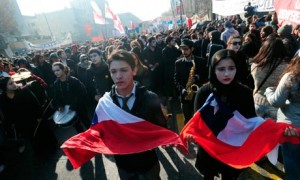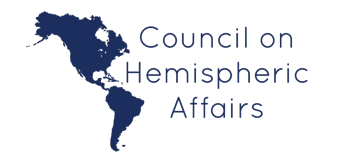Chile’s Student Rebels: Views From The Trenches
Radio Toma, loosely translated as “Occupation Radio,” broadcasts non-stop information about the protests being staged in front of the University of Chile’s main building – literally a stone’s throw away from the Presidential Palace of La Moneda. Since June 10, students have occupied the beautiful neoclassical 19th Century campus as the protests have continued to intensify around their one demand – to dismantle the market-based approach of the Chilean educational system, something they have scornfully come to label “Pinochet’s education.”
“We just distrust the political class,” one of the students in front of Radio Toma told me. But even when the political establishment tried to discredit their protests, students’ responses turned out to be well-organized. They are fully cognizant of their role in trying to overhaul not only the educational system, but the tense democratic framework put in place by the Pinochet regime as well.
The media so far has been complacent in its coverage. Except for the same international agencies which tend to cover the protests from the political trenches, Chilean media seemed very cozy inside the tall steel gates of the Club Hípico, where flustered cameramen and news commentators took pictures, argued about attendance and whether the march would take a turn for the worse. Unlike the conventional narrative, these protests are not limited to the wayward acts of “subversive vagrants” (as the gaffe-prone Senator Carlos Larraín publicly derided), or even worse, a lighthearted, middle-class uprising – a view implicit in the New York Times and in a recent interview with neoliberal pundit Moises Naím.
All of these fractures are also being seen in Chile’s Winter of Discontent. Eerily reminiscent of previous shifts, today they pit the demands of a growing (as well as younger) cohort of citizens against a traditional elite who are desperately trying to buy themselves legitimacy and time, all the while being cognizant of the fact that this year’s campus activist is likely the next decade’s presidential candidate.
When I asked about the endgame at Radio Toma, the two students there nodded – “look, honestly we don’t know where this is going to end. We do not own society’s demands. This movement is dynamic in nature… but in the end it all boils down to a conflict in legality.” As he said this, we heard the sound of hundreds of sneakers treading across the sidewalk. He looked at me, excused himself very politely and ran into the building, all as the police quickly moved in and sprayed everyone with fast speed, heavy volume water cannons.
A few hours before, as the march departed from the Universidad de Santiago station, the mood was jovial – under the loud and constant tapping of police helicopters, people drummed, danced, chanted and waved banners against what they deemed as Piñera’s tone-deaf attempt to save, at all costs and against their wishes, the educational compact dating back from the Pinochet era.
Two veterans of these protests, Manuel and Carlos, watched the march from one of the more festive corners of the protest. At the Avenida España and Claudio Gay intersection, people in the balconies were throwing sacks of water and confetti on top of the students and singing along with their tunes taken from other songs, in an attempt to freshen-up the protesters as a surprisingly beautiful spring day was made more pungent by the multitude. “I have not seen so much people since the No Protests,” Manuel said, while Carlos nodded along. Both had been tortured during those violent episodes that rocked Chile for months during the heady days of the Pinochet regime after the economy plummeted in 1982. But as the thousands of teenagers and twenty-somethings streamed into the street, they could not help smiling – “we have to give it to them. These kids have extraordinary courage. I can only hope they can change what we failed to do, because we were afraid…”
Yet, students are surprisingly modest in their demands. Cristóbal Lagos, Secretary General of the Universidad de Chile’s Student Federation, one of the biggest student unions spearheading the effort, recognized the matter plainly as we walked down the street into Almagro Park, where the march would ultimately congregate – “we don’t like Piñera, but we don’t want to break the institutional framework. However, if after this movement others [movements] are born, that’s better. Because of what we are doing, people will come out and demand real change in Chile.”
But despite the appeals for calm, I spoke with one of the up-to-no-gooders in full combat paraphernalia as he taunted the police in one of the side streets near the area – he said that they were allowed to go past La Alameda, but he was lying – the area was clearly off-limits. As more and more people flooded the park’s bounds, tensions started to flare despite desperate efforts to keep calm on both sides. As the march turned around down the streets of Manuel Matta and Nathaniel Cox, I witnessed the frantic efforts of one parent (as he called himself while he herded the students into the designated route) who stood between the students and the police, as some anonymous rocks fell dud, short from the heavily armored police.
As the hundred thousand-strong march flowed through the decently sized park, it didn’t take long for the protest to trickle beyond the strictly defined “designated” area by the government, and towards the menacing police barricades. While the author ran across the side streets around the park, it was clear that both protesters and police were uncomfortable near each other’s inherently dangerous presence. One can be excused for being slightly subjective on such subjects of several germane subjects since when one comes from Panama, where until very recently and despite some particularly morose circumstances, police and students were prone to negotiate, interact and even, jokingly, defuse tensions during policy oriented protests. These antics could have just as well been carried out on the sidelines of a World Cup soccer match same as could be carried out in one of Pinochet’s or his Panamanian counterpart’s torture chambers. Panama has changed, much like Chile has taken on an unattractive cast, even while bearing a democratic garb. In a new world of austerity and economic crises, a fractured society where Chilean carabineros are once again being restored to power while Chilean students are once again losing their innocence, the police think nothing of fiercely answering the taunts of the kids with their kaffiye covered faces, to be followed without much provocation, later, experienced, and now camped-in at Radio Toma, and where students are emboldened enough to retaliate the scorn with rocks that they harvested from potholes in the street.
It is very difficult to see where this will end politically – divisions seem to be growing as we speak. Once again, there are some scattered references to UNAM protests in Mexico, where students unsuccessfully, if bitterly, occupied the university for almost a year to protest against tuition increases. These students now have recognized, they cannot alienate society without creating channels to carry away the angst that pervades Chilean society. “Those protesting today, we are the same pinguinos (colloquial for students in Chile) who protested in 2006, and who were cajoled by the Concertación‘s roundtables and big plans that amounted to nothing…” the students at Radio Toma said, as they explained their distrust towards the government’s appeals for negotiation. Feeling no love for the Concertación, who they see as the same elites with different stripes, they view themselves as a movement that is hurriedly coagulating different political aspirations, producing water instead of blood.
“We’ve held out for three months… if we get something now, it has to be big.”


